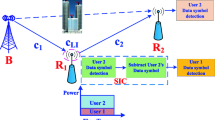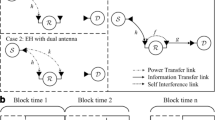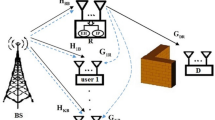Abstract
In this paper, we consider full-duplex (FD) two-way relaying networks, where wireless power transfers from hybrid power access-point, H to user and wireless information transmits from user to H via relay. We propose FD-based power splitting (PS) and time-switching (TS) protocols which enables the energy harvesting (EH) and information processing at relay. These protocols overcome the limitation of spectral efficiency and in band self-interference caused by half-duplex relaying and operation of FD respectively. The energy constraint nodes such as relay and user harvest energy from H by radio-frequency signal, where relay also harvests energy by self-energy recycling. The optimal PS ratio and the optimal TS ratio are investigated and expressed in closed-form. With Rayleigh fading channel, we derive the end-to-end ergodic capacity for PS and TS protocols. Numerical results show that our proposed FD-based EH schemes outperform the benchmark schemes significantly. In particular, the PS protocol is superior to TS protocol at high transmit power of H while at low transmit power of H, TS protocol is better than the PS protocol.









Similar content being viewed by others
References
Vullers, R. J. M., Schaijk, R. V., Doms, I., Hoof, C. V., & Mertens, R. (2009). Micropower energy harvesting. Elsevier Solid-State Circuits, 53(7), 684–693.
Varshney, L. R. (2008). Transporting information and energy simultaneously. In IEEE international symposium on information theory, Toronto, ON, Canada (pp. 1612–1616).
Grover, P., & Sahai, A. (2010). Shannon meets Tesla: wireless information and power transfer. In Proceedings 2010 IEEE international symposium on information theory, Austin, TX, USA (pp. 2363–2367).
Popovski, P., Fouladgar, A. M., & Simeone, O. (2013). Interactive joint transfer of energy and information. IEEE Transactions on Communications, 61(5), 2086–2097.
Zhang, R., & Ho, C. K. (2013). MIMO broadcasting for simultaneous wireless information and power transfer. IEEE Transactions on Wireless Communications, 12(5), 31989–32001.
Nasir, A. A., Zhou, X., Durrani, S., & Kennedy, R. A. (2013). Relaying protocols for wireless energy harvesting and information processing. IEEE Transactions on Wireless Communications, 12(7), 3622–3636.
Chen, H., Li, Y., Rebelatto, J. L., Filho, B. F. U., & Vucetic, B. (2015). Harvest-then-cooperate: Wireless-powered cooperative communications. IEEE Transactions on Signal Processing, 63(7), 1700–1711.
Nasir, A. A., Zhou, X., Durrani, S., & Kennedy, R. A. (2015). Wireless-powered relays in cooperative communications: Time-switching relaying protocols and throughput analysis. IEEE Transactions on Communications, 63(5), 1607–1622.
Gu, Y., & Aïssa, S. (2105). RF-based energy harvesting in decode-and-forward relaying systems: Ergodic and outage capacities. IEEE Transactions on Wireless Communications, 14(11), 6425–6434.
Liu, P., Gazor, S., Kim, I. M., & Kim, D. I. (2015). Noncoherent relaying in energy harvesting communication systems. IEEE Transactions on Wireless Communications, 14(12), 6940–6954.
Xiong, K., Fan, P., Zhang, C., & Letaief, K. B. (2015). Wireless information and energy transfer for two-hop non-regenerative MIMO-OFDM relay networks. IEEE Journal on Selected Areas in Communications, 33(8), 1595–1611.
Huang, G., Zhang, Q., & Qin, J. (2015). Joint time switching and power allocation for multicarrier decode-and-forward relay networks with SWIPT. IEEE Signal Processing Letters, 22(12), 2284–2288.
Kashef, M., & Ephremides, A. (2016). Optimal partial relaying for energy-harvesting wireless networks. IEEE/ACM Transaction on Networking, 24(1), 113–122.
Huang, X., & Ansari, N. (2016). Optimal cooperative power allocation for energy-harvesting-enabled relay networks. IEEE Transactions on Vehicular Technology, 65(4), 2424–2434.
Ding, H., Wang, X., Costa, D. B. D., Chen, Y., & Gong, F. (2017). Adaptive time-switching based energy harvesting relaying protocols. IEEE Transactions on Communications, 65(7), 2821–2837.
Tutuncuoglu, K., Varan, B., & Yener, A. (2015). Throughput maximization for two-way relay channels with energy harvesting nodes: The impact of relaying strategies. IEEE Transactions on Communications, 63(6), 2081–2093.
Zeng, Y., Chen, H., & Zhang, R. (2016). Bidirectional wireless information and power transfer with a helping relay. IEEE Communications Letters, 20(5), 862–865.
Liu, Y., Wang, L., Elkashlan, M., Duong, T. Q., & Nallanathan, A. (2016). Two-way relay networks with wireless power transfer: Design and performance analysis. IET Communications, 10(14), 1810–1819.
Salem, A., & Hamdi, K. A. (2016). Wireless power transfer in multi-pair two-way AF relaying networks. IEEE Transactions on Communications, 64(11), 4578–4591.
Alsharoa, A., Ghazzai, H., Kamal, A. E., & Kadri, A. (2017). Optimization of a power splitting protocol for two-way multiple energy harvesting relay system. IEEE Transactions on Green Communications and Networking, 1(4), 444–457.
Li, S., & Murch, R. D. (2014). An investigation into baseband techniques for single-channel full-duplex wireless communication systems. IEEE Transactions on Wireless Communications, 13(9), 4794–4806.
Zhong, C., Suraweera, H., Zheng, G., Krikidis, I., & Zhang, Z. (2014). Wireless information and power transfer with full duplex relaying. IEEE Transactions on Communications, 62(10), 3447–3461.
Zeng, Y., & Zhang, R. (2015). Full-duplex wireless-powered relay with self-energy recycling. IEEE Wireless Communications Letter, 4(2), 201–204.
Wang, D., Zhang, R., Cheng, X., & Yang, L. (2017). Capacity-enhancing full-duplex relay networks based on power-splitting (PS-) SWIPT. IEEE Transactions on Vehicular Technology, 66(6), 5446–5450.
Le, Q. N., Bao, V. N. Q., & An, B. (2018). Full-duplex distributed switch-and-stay energy harvesting selection relaying networks with imperfect CSI: Design and outage analysis. Journal of Communications and Networks, 20(1), 29–46.
Park, J. J., Moon, J. H., & Kim, D. I. (2016). Time-switching based in-band full duplex wireless powered two-way relay. In URSI Asia-Pacific radio science conference (URSI AP-RASC), South Korea (pp. 438–441).
Park, J. J., Moon, J. H., & Kim, D. I. (2016). Energy signal design and decoding procedure for full-duplex two-way wireless powered relay. In URSI Asia-Pacific radio science conference (URSI AP-RASC), South Korea (pp. 442–445).
Wang, D., Zhang, R., Cheng, X., Yang, L., & Chen, C. (2017). Relay selection in full-duplex energy harvesting two-way relay networks. IEEE Transactions on Green Communications and Networking, 1(2), 182–191.
Chen, G., Xiao, P., Kelly, J. R., Li, B., & Tafazolli, R. M. (2017). Full-duplex wireless-powered relay in two way cooperative networks. IEEE Access, 5, 1548–1558.
Jiang, D., Xu, Z., Li, W., & Chen, Z. (2015). Network coding-based energy-efficient multicast routing algorithm for multi-hop wireless networks. Journal of Systems and Software, 104, 152–165.
Jiang, D., Xu, Z., Li, W., & Chen, Z. (2017). Topology control-based collaborative multicast routing algorithm with minimum energy consumption. International Journal of Communication Systems, 30(1), 1–18.
Jiang, D., Li, W., & Lv, H. (2017). An energy-efficient cooperative multicast routing in multi-hop wireless networks for smart medical applications. Neurocomputing, 220, 160–169.
Jiang, D., Shi, L., Zhang, P., & Ge, X. (2016). QoS constraints-based energy-efficient model in cloud computing networks for multimedia clinical issues. Multimedia Tools and Applications, 75(22), 14307–14328.
Jiang, D., Liu, J., Lv, Z., Dang, S., Chen, G., & Shi, L. (2016). A robust energy-efficient routing algorithm to cloud computing networks for learning. Journal of Intelligent and Fuzzy Systems, 31(5), 2483–2495.
Jiang, D., Huo, L., Lv, Z., Song, H., & Qin, W. (2018). A joint multi-criteria utility-based network selection approach for vehicle-to-infrastructure networking. IEEE Transactions on Intelligent Transportation Systems, 19(10), 3305–3319.
Huo, L., Jiang, D., & Lv, Z. (2018). Soft frequency reuse-based energy efficiency optimization algorithm for cellular multi-cell networks. Computers & Electrical Engineering, 66(C), 1–16.
Jiang, D., Zhang, P., Lv, Z., & Song, H. (2016). Energy-efficient multi-constraint routing algorithm with load balancing for smart city applications. IEEE Internet of Things Journal, 3(6), 1437–1447.
Jiang, D., Huo, L., & Li, Y. (2018). Fine-granularity inference and estimations to network traffic for SDN. PLoS ONE, 13(5), 1–23.
Ju, H., & Zhang, R. (2014). Throughput maximization in wireless powered communication networks. IEEE Transactions on Wireless Communications, 13(1), 418–428.
Ju, H., & Zhang, R. (2014). User cooperation in wireless powered communication networks. In IEEE global communication conference (GLOBECOM), Austin, TX, USA (pp. 1430–1435).
Abramowitz, M., & Stegun, I. A. (1964). Handbook of mathematical functions with formulas, graphs and mathematical tables. National Bureau of Standards Applied Mathematics Series: 5. Washington, DC: Dept. of Commerce, National Bureau of Standards.
Papoulis, A., & Pillai, S. U. (2002). Probability, random variables, and stochastic processes (4th ed., pp. 169–242). Pennsylvania: McGraw Hill Education.
Gradshteyn, I. S., & Ryzhik, I. M. (2007). Table of integrals, series, and products (7th ed.). San Diego: Academic Press.
Acknowledgements
The authors are grateful to the anonymous reviewers, Editor and Editor-in-Chief for their valuable suggestions to improve the quality of paper.
Author information
Authors and Affiliations
Corresponding author
Additional information
Publisher's Note
Springer Nature remains neutral with regard to jurisdictional claims in published maps and institutional affiliations.
Appendices
Appendix 1
1.1 Proof of Theorem 1
In this appendix, we derive the closed-form expression of PS ratio for FD-based EH in two-way AF relaying system. From (19), we can observe that the end-to-end ergodic capacity for PS protocol should be maximized when we maximize the SINR from u-to-H, \(\gamma_{uH}^{PS} \left( \alpha \right)\). For maximizing \(\gamma_{uH}^{PS} \left( \alpha \right)\), we minimize the denominator of (18). For computing the PS ratio, we follow some important steps which is given below.
Step 1: We consider denominator of (18) that can be written as
where \(a_{1} = \left| {h_{1} } \right|^{2} \sigma_{R}^{2}\), \(a_{2} = \xi \left| {h_{2} } \right|^{4} \sigma_{H}^{2}\) and \(a_{3} = \frac{{\left( {1 - \xi \left| {h_{R} } \right|^{2} } \right)\sigma_{R}^{2} \sigma_{H}^{2} }}{{\xi P_{H} \left| {h_{1} } \right|^{2} }}\).
Step 2: The derivative of \(\tilde{\gamma }\left( \alpha \right)\) with respect to \(\alpha\) can be expressed as
Step 3: We set \(\frac{{\delta \tilde{\gamma }\left( \alpha \right)}}{\delta \alpha }\) to be zero and then we obtain polynomial in \(\alpha\) as
It is difficult to tractable the closed-form expression of PS ratio,\(\alpha\). Note that the term \(\frac{{a_{3} }}{{a_{2} }} \propto \frac{1}{{P_{H} }}\). Thus, we consider special case as transmit power of H, \(P_{H}\) is very large i.e., \(a_{3} \approx 0\). Hence, polynomial of (54) can be rewritten as
where \(a = \frac{{2a_{1} }}{{a_{2} }} = \frac{{2\left| {h_{1} } \right|^{2} \sigma_{R}^{2} }}{{\xi \left| {h_{2} } \right|^{4} \sigma_{H}^{2} }}\).
The roots of \(\alpha\) can be evaluated with the help of [41, 3.8.3] as
Step 4: We obtain second derivative of \(\tilde{\gamma }\left( \alpha \right)\) with respect to \(\alpha\) as
Since, value of \(\alpha\) defines in the range of 0 to 1 i.e., \(0 \le \alpha \le 1\). Thus, we observe that the \(\frac{{\delta^{2} \tilde{\gamma }\left( \alpha \right)}}{{\delta \alpha^{2} }} \ge 0\). Further, we achieve that the \(\tilde{\gamma }\left( \alpha \right)\) is minimum at \(\alpha = 1 - \frac{1}{2}\left[ {\sqrt {a\left( {a + 4} \right)} - a} \right]\). The denominator of \(\gamma \left( \alpha \right)\) i.e., \(\tilde{\gamma }\left( \alpha \right)\) is convex with \(\in \left( {0, 1} \right)\). Thereby, SINR from user to H, \(\gamma_{uH}^{PS} \left( \alpha \right)\) is concave with \(\alpha \in \left( {0, 1} \right)\). Finally, we conclude that the end-to-end capacity from u-to-H for PS protocol achieves maximum at \(\alpha = 1 - \frac{1}{2}\left[ {\sqrt {a\left( {a + 4} \right)} - a} \right]\). Thus, this completes the Proof of Theorem 1.
Appendix 2
2.1 Proof of Theorem 2 and Lemma 1
In this section, we investigate the closed-form expression of ergodic capacity from u-to-H for Rayleigh fading.
Proof of Theorem 1
We assume that the fading gains \(x = \left| {h_{1} } \right|^{2}\), \(y = \left| {h_{2} } \right|^{2}\) and residual self-interference channel gain, \(z = \left| {h_{R} } \right|^{2}\) are exponential distributed and followed by Rayleigh fading with means \(\mu_{1} = {\mathbb{E}}\left\{ {\left| {h_{1} } \right|^{2} } \right\}\), \(\mu_{2} = {\mathbb{E}}\left\{ {\left| {h_{2} } \right|^{2} } \right\}\) and \(\mu_{R} = {\mathbb{E}}\left\{ {\left| {h_{R} } \right|^{2} } \right\}\) respectively. The joint probability density function (pdf) of \(x\), \(y\), and \(z\) is defined in [42] as \(f_{XYZ} \left( {x, y, z} \right) = \frac{1}{{\mu_{1} \mu_{2} \mu_{R} }}e^{{ - \left( {\frac{x}{{\mu_{1} }} + \frac{y}{{\mu_{2} }} + \frac{z}{{\mu_{R} }}} \right)}}\). Therefore, the ergodic capacity from u-to-H is expressed as
Substituting (17) and \(f_{XYZ} \left( {x, y, z} \right)\) in (58), we can write ergodic capacity from u-to-H as
Note that the set of value, \(\left\{ {b_{1} , b_{2} , b_{3} , b_{4} , b_{5} } \right\}\) has been written in (23). We lookup table [43, 3.354.2] and then evaluate ergodic capacity from u-to-H as (22). Thus, this completes the proof of Theorem 2.
Proof of Lemma 1
We assume that the channel gain from H-to-R, \(\left| {h_{1} } \right|^{2}\) and residual self-interference channel gain, \(\left| {h_{R} } \right|^{2}\) are stationary and channel gain from u-to-R, \(\left| {h_{2} } \right|^{2}\) is exponentially distributed and followed by Rayleigh fading. The pdf of function of y defines as, \(f_{Y} \left( y \right) = \frac{1}{{\mu_{2} }}e^{{ - \left( {\frac{y}{{\mu_{2} }}} \right)}}\). Thereby, the ergodic capacity from u-to-H is given by
With the help of table in [42, 3.354.2] and (17), we evaluate the ergodic capacity from u-to-H as (24). Thereby, the proof of Lemma 1 is completed.
Appendix 3
3.1 Proof of Theorem 3
In this appendix, we evaluate the closed-form expression of TS ratio for FD-based EH in two-way AF relaying.
Proof of Theorem 3
Substituting (40) into (42), we can express the end-to-end channel capacity for TS protocol as
Note that the ratio, \(\frac{{f_{3} }}{{f_{2} }} \propto \frac{1}{{P_{H} }}\). We assume that the \(P_{H} \gg P_{u}^{TS}\). Therefore, \(f_{3} \approx 0\). The (61) can be rewritten as
where \(f_{0} = f_{1} f_{2}\). We follow steps to compute the TS ratio which is given below.
Step 1: We derivate (62) with respect to \(\delta\) and it can be written as
Step 2: We set derivative in (63) to be zero. We get
where \(\varepsilon = \left( {\frac{1}{{f_{0} }} - 1} \right)e^{ - 1}\) and \(p = \frac{{\left( {1 - \delta } \right)\left( {1 - f_{0} } \right)}}{{f_{0} \left( {1 - \delta } \right) + \left( {1 + \delta } \right)}}\).Thus, we obtain TS ratio as (43).
Step 3: The second derivative of (62) can be expressed as
From (65), it is clear that the \(\frac{{\partial^{2} C_{uH}^{TS} \left( \delta \right)}}{{\partial \delta^{2} }} \le 0\) with \(\delta \in \left[ {0, 1} \right]\). Thus, the end-to-end capacity from u-to-H for TS protocol is maximum at \(\delta\) that is given in (43). The proof of Theorem 3 is completed.
Appendix 4
4.1 Proof of Theorem 4 and Lemma 2
In this appendix, we investigate the end-to-end ergodic capacity from u-to-H for TS protocol.
Proof of Theorem 4
Similar to “Appendix 2”, we considered gains, \(\left\{ {x, y, z} \right\}\) and joint pdf. The end-to-end ergodic capacity from u-to-H with TS protocol for Rayleigh fading is expressed as
By substituting (40) in (66), we can write as
The set of value, \(\left\{ {k_{0} , k_{1} , k_{2} , k_{3} } \right\}\) has been given in (46). We see [42, 3.354.2] and then compute ergodic capacity from u-to-H as (45). Thereby, the proof of Theorem 4 is completed.
Proof of Lemma 2
For TS protocol, we follow same condition as Lemma 1 and then we obtain end-to-end channel capacity from u-to-H can be written as
With the help of table in [42, 3.354.2] and (40), we evaluate the ergodic capacity from u-to-H for TS protocol as (47). Thus, this completes the proof of Lemma 2.
Rights and permissions
About this article
Cite this article
Kumar, R., Hossain, A. Full-duplex wireless information and power transfer in two-way relaying networks with self-energy recycling. Wireless Netw 26, 6139–6154 (2020). https://doi.org/10.1007/s11276-020-02432-x
Published:
Issue Date:
DOI: https://doi.org/10.1007/s11276-020-02432-x




